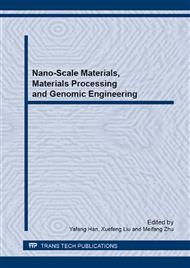[1]
Jun Zhuang, Heat Pipes Tech &Eng Applications, Chem. Indust. Beijing, Press (2000).
Google Scholar
[2]
Weilin Zhao, Zongming Liu, Yanxiang Guan, Dongdong Li, Literature review based on the nanofluid heat pipe, Chemical Machinery, 36(2009)83.
Google Scholar
[3]
Junhong Liu, Jianming Gu, Hui Liu, The research on the nanoparticles application to heat pipe, Nuclear Power Engineering, 26(2005) 268- 271.
Google Scholar
[4]
Tsa i C Y, Chien H T, Chan B et al., Effect of structural character of gold nanoparticles in nanofluid on heat pipe thermal performance, Materials Letters, 58(2004) 1461-1465.
DOI: 10.1016/j.matlet.2003.10.009
Google Scholar
[5]
Ma H B, Wilson C, Borgmeyer B et al., Effect of nanofluid on the heat transport capability in an oscillating heat pipe, Applied Physics Letters, (2006) 88.
DOI: 10.1063/1.2192971
Google Scholar
[6]
Tao Shu, Zhenhua Liu, Application of nanofluid in thermal performance enhancement of horizontal screen heat pipe, Journal of Aerospace Power, 23(2008)1795-1799
Google Scholar
[7]
Dongdong Li, Jinkai Li, Weilin Zhao, Stability and thermal conductivity of SiO2-water nanofluid [J], Journal of University of JINAN (Sci. & Tech.), 24(2010)247-250.
Google Scholar
[8]
Buxuan Wang, Chunhui Li, Xiaofeng Peng, Nanoparticle suspension stability analysis[J], Journal of Basic Science And Engineering,11(2003)167-173.
Google Scholar
[9]
Nan Wang, Jun Chen, Qingsong An, Lin Shi, Elementary research on the dispersion and stability of nanofluids by molecular dynamics simulations, Journal of Engineering Thermophysics, 32(2011) 1107-1110.
Google Scholar
[10]
Chang H, Chih Hung Lo, Tsing TshihTsung, et al., Temperature effect on the stability of CuO nanofluids based on measured particle distribution, Materials, 295-296(2005) 51-56.
DOI: 10.4028/www.scientific.net/kem.295-296.51
Google Scholar
[11]
Xinfang Li, Dongsheng Zhu, Xianjv Wang, Nan Wang, Hua Li, Shuo Yang, The research on Cu-H2O nanofluids dispersion behavior and thermal properties, Functional Materials, 1(2008)162-168.
Google Scholar
[12]
Xinfang Li, Dongsheng Wang, Xianjv Wang, Nan Wang, Effect factor and function mechanism on dispersion and stability of Cu nanoparticle,Chemical Engineering (China), 35(2007)46-50.
Google Scholar


